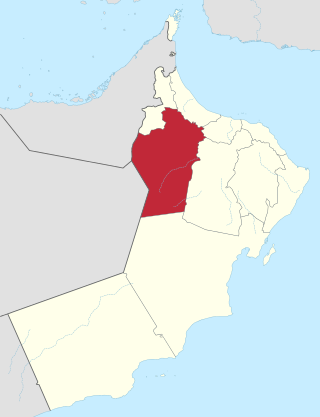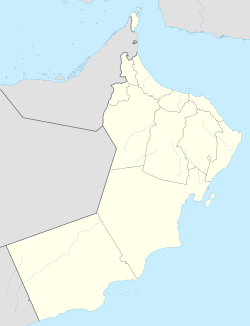
Muscat is the capital and most populated city in Oman. It is the seat of the Governorate of Muscat. According to the National Centre for Statistics and Information (NCSI), the total population of Muscat Governorate was 1.72 million as of September 2022. The metropolitan area spans approximately 3,500 km2 (1,400 sq mi) and includes six provinces called wilayats, making it the largest city in the Arabian Peninsula by area. Known since the early 1st century AD as an important trading port between the west and the east, Muscat was ruled by various indigenous tribes as well as foreign powers such as the Persians, the Portuguese Empire and the Ottoman Empire at various points in its history. A regional military power in the 18th century, Muscat's influence extended as far as East Africa and Zanzibar. As an important port-town in the Gulf of Oman, Muscat attracted foreign traders and settlers such as the Persians, Balochs and Sindhis. Since the accession of Qaboos bin Said as Sultan of Oman in 1970, Muscat has experienced rapid infrastructural development that has led to the growth of a vibrant economy and a multi-ethnic society. Muscat is termed as a Beta - Global City by the Globalization and World Cities Research Network.

The Dhofar Governorate is the largest of the 11 governorates in the Sultanate of Oman in terms of area. It lies in southern Oman, on the eastern border with Yemen's Al Mahrah Governorate and the southern border with Saudi Arabia's Eastern Province. It is a rather mountainous area that covers 99,300 km2 (38,300 sq mi) and had a population of 416,458 in the 2020 census. Salalah is the largest city and capital of the governorate. Historically, the region was a source of frankincense. The local dialect of Arabic is Dhofari Arabic, which is distinct from that used in the rest of Oman and in Yemen.

The administrative division of Oman contains eleven governorates (muhafazah):

Ad Dakhiliyah is one of the eleven governorates (muhafazah) of Oman with Nizwa town as the regional center. It was previously a region (mintaqah). It became a governorate on 28 October 2011.
Raysut is a port town in southwestern Oman. It is located in the Dhofar Governorate.

Taqah is a wilayat (province) and coastal town of the Dhofar Governorate, in southwestern Oman. It is located at about 17°2′14″N54°24′13″E. The nature of the Taqah wilayat is diverse, as it is a coastal province with beaches, plains, and mountains. It is also known for the presence of caves, such as the caves of Taqah and the caves of Wadi Darbat. Additionally, Taqah has two inlets, Khawr Taqah and Khawr Rawri, both declared as protected areas within the Alkhawr Coastal Nature Reserves by virtue of Royal Decree No. 49/97. The wilayat also features the springs of Ain Khawr Taqah and Ain Darbat, known for their waterfalls."
Al Suwaiq is a coastal wilayah (province) in Al Batinah North Governorate, in northeastern Oman. The province has historically been an economic hub, attracting residents from the surrounding areas, its strategic location facilitating trade and commerce.
Al-Saadah is a coastal town 30–40 km from Salalah in the southern Omani governorate of Dhofar. There are a few supermarkets, shops, schools and colleges in the town, as well as a police station and a healthcare centre run by the Ministry of Health. Saadha is linked to the nearby towns of Taqa, Mirbat, and Thumrait by motorable roads.

Al Buraimi Governorate is one of the 11 governorates of Oman. The area was part of Ad Dhahirah Region until October 2006, when a new governorate was created from the Wilayats (Provinces) of Al Buraymi and Mahdah. A third wilayat, As-Sunaynah, was created from parts of the two. Dr. Hamad bin Ahmed Al Busaidi has been governor since 2020.

Muscat is a governorate of the Sultanate of Oman. Its provincial capital is Muscat, which is the largest city and only metropolis of Oman. Muscat Governorate, commonly referred to as Muscat City, is the seat of government and contains Oman's first cruise and cargo port and oil port. Its population reached 1,288,330 as of May 2015.

Ash Sharqiyah North Governorate is a governorate of Oman. It was created on 28 October 2011, when Ash Sharqiyah Region was split into Ash Sharqiyah North Governorate and Ash Sharqiyah South Governorate. The centre of the governorate is the wilāyah (province) of Ibra.

Ash Sharqiyah South Governorate is a governorate of Oman. It was created on 28 October 2011 when Ash Sharqiyah Region was split into Ash Sharqiyah North Governorate and Ash Sharqiyah South Governorate. The centre of the governorate is the Wilayat of Sur.

Al Dhahirah Governorate is one of the eleven governorates (muhafazah) of Oman. It was previously a region (mintaqah), and became a governorate on 28 October 2011. The largest city in the governorate is Ibri.
Al Khaburah is a Wilayat of Al Batinah North in the Sultanate of Oman.
Al Musanaah is a Wilayat of Al Batinah South in the Sultanate of Oman.
Wadi Bani Khaled is a Wilayat of Ash Sharqiyah North in the Sultanate of Oman.

Dema Wa Thaieen is a Wilayat of Ash Sharqiyah North in the Sultanate of Oman.
Al Kamil W'al Wafi is a region in the South Al Sharqiyah Governorate that is surrounded by the wilayats of Wadi Bani Khalid, Sur, and Jaalan Bani Bu Hassan to the north, west, and south, respectively. About 40 clusters make up its population centers, including Al-Kamil, Al-Wafi, Tawi Hatim, Tahwa, and Tawi.
Dhalkut is a wilayat or province of Dhofar Governorate in the Sultanate of Oman.












